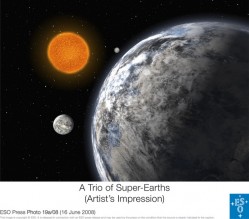The Universe is always surprising us with how little we know about… the Universe. It’s continuously presenting us with stuff we never imagined, or even thought possible. The search for extrasolar planets is a great example.
Since we started, astronomers have turned up over a thousand of them. These planets can be gigantic worlds with many times the mass of Jupiter, all the way down to little tiny planets smaller than Mercury. Astronomers are also finding one type of world that feels both familiar and yet totally alien… the super earth.
In the strictest sense, a super earth is just a planet with more mass than Earth, but less than a larger planet like Uranus or Neptune. So, you could have super earths made of rock and metal, or even ice and gas. These planets could have oceans and atmospheres, or made of nothing but hydrogen and helium. The goal, of course, is to find a rocky super earth located in the habitable zone. This is the region where the planets are the right distance from the star for liquid water to be present.
The first discovery of a potentially habitable super earth was in the star system Gliese 581.
Here, astronomers found 2 planets orbiting within the habitable zone. Gliese 581 c has a mass of 5 times the Earth, and orbits on the overly warm side of the habitable zone and, Gliese 581 d is 7.7 times the mass of the Earth, and is on the cold side of the zone.
We’ve now found dozens of super earths. One recent discovery, Kepler 11-b, has only 4 times the mass of the our planet and just 1.5 times its size.
You’re probably wondering about the gravity. The exact gravity depends on the ratio of the planet’s size to its mass. If you could stand on the surface of a super earth, you’d probably feel a higher gravity. Considering these planets can have 5 or more times the mass of Earth. But less gravity than you’d expect.
An increase in size makes a big difference. For example, if you could stand on the surface of Kepler 11-b, which is about 1.5 times bigger but a whopping 4 times more massive, you’d feel only 1.4 times the pull of Earth’s gravity.

Here’s the big question. Could a super earth support life?
Aquatic life would be no problem. Once you’re in the ocean, the effects of gravity are balanced out by the buoyancy of water. How well life could survive on land and in the air depends on the gravity of the world. With higher gravity, plants and animals wouldn’t be able to grow as tall. Animals would need thicker legs to support their weight. If the atmosphere was denser, likely because of the higher gravity, flying creatures could move more slowly with larger wingspans.
If intelligent life does develop on a heavy gravity world, it will have a much harder time getting into space. Reaching orbital velocity is already tremendously difficult from Earth. Just imagine how much more difficult it would be to launch rockets if everything was twice as heavy.
So, a big thank you to the astronomers showing us that there are all kinds of crazy worlds out there.
I just wish they weren’t so far away.

